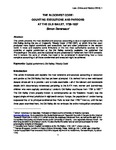The Bloodiest Code: Counting Executions and Pardons at the Old Bailey, 1730-1837
| dc.contributor.author | Devereaux, Simon | |
| dc.date.accessioned | 2017-03-14T16:44:19Z | |
| dc.date.accessioned | 2017-04-11T09:06:23Z | |
| dc.date.available | 2017-03-14T16:44:19Z | |
| dc.date.available | 2017-04-11T09:06:23Z | |
| dc.date.issued | 2016 | |
| dc.identifier.citation |
Devereaux, S. (2016) 'The Bloodiest Code: Counting Executions and Pardons at the Old Bailey, 1730-1837', Law, Crime and History, 6(1), pp. 83–102. Available at: https://pearl.plymouth.ac.uk/handle/10026.1/8928 | en_US |
| dc.identifier.issn | 2045-9238 | |
| dc.identifier.uri | http://hdl.handle.net/10026.1/8928 | |
| dc.description.abstract |
This article presents the most detailed and accurate accounting to date of capital convicts at the Old Bailey during the era of England’s ‘Bloody Code’ (1730-1837), at which time that court produced more capital convictions and executions than any other jurisdiction in the western world. It notes and explains some limitations of the two most authoritative sources for the statistics of capital punishment at the Old Bailey currently available: the published trial Proceedings of the court; and the statistical returns presented to Parliament from 1818 onwards. And it reviews the sorts of criteria that need to be considered in determining how a more complete accounting of all those condemned and executed might be achieved. | en_US |
| dc.language.iso | en | en_US |
| dc.publisher | University of Plymouth | |
| dc.rights | Attribution 4.0 International (CC BY 4.0) | * |
| dc.rights.uri | https://creativecommons.org/licenses/by/4.0/ | * |
| dc.subject | Capital punishment | en_US |
| dc.subject | Old Bailey | en_US |
| dc.subject | ‘Bloody Code’ | en_US |
| dc.title | The Bloodiest Code: Counting Executions and Pardons at the Old Bailey, 1730-1837 | en_US |
| dc.type | Article | en_US |
| dc.type | Article | |
| plymouth.issue | 1 | |
| plymouth.volume | 6 | |
| plymouth.journal | SOLON Law, Crime and History |



